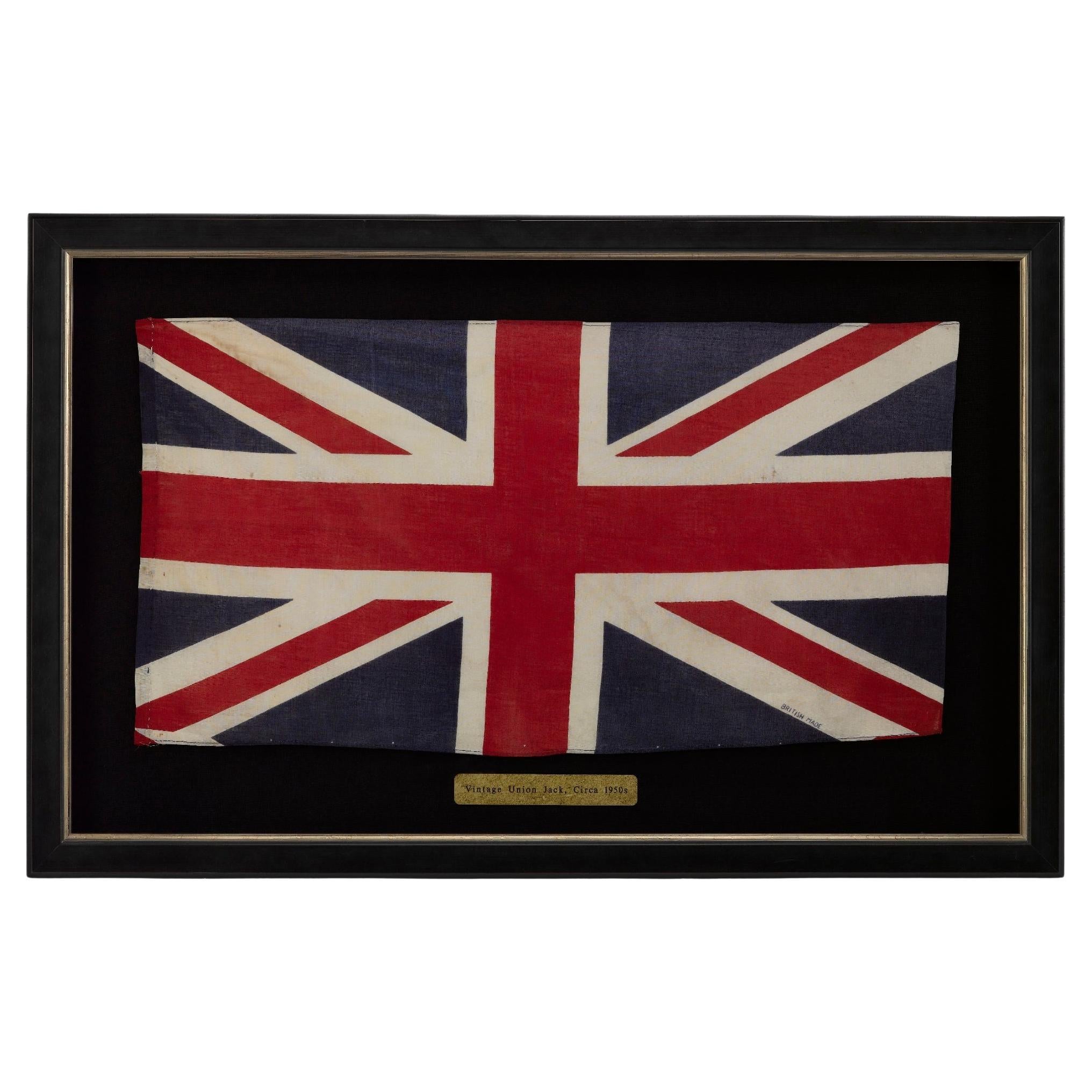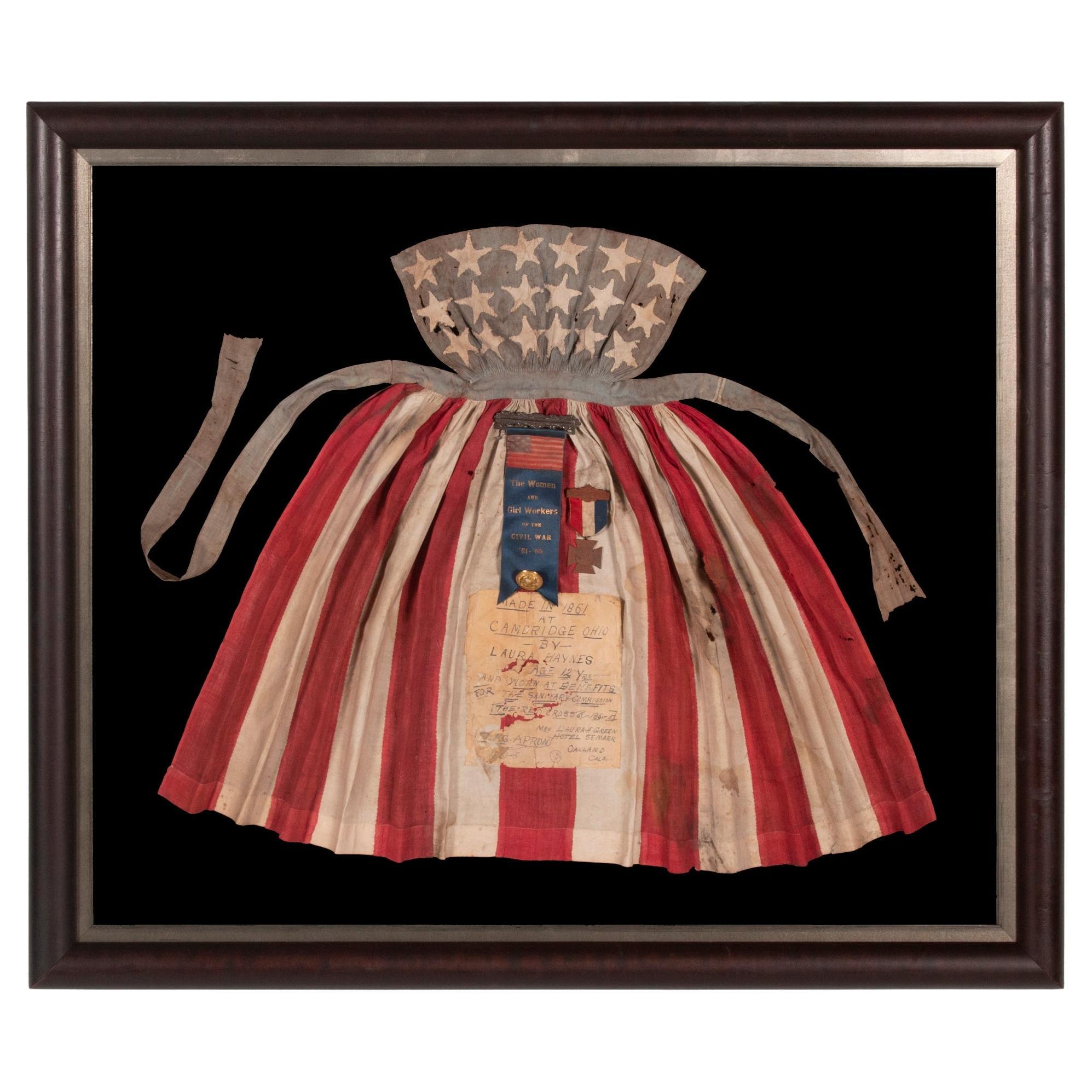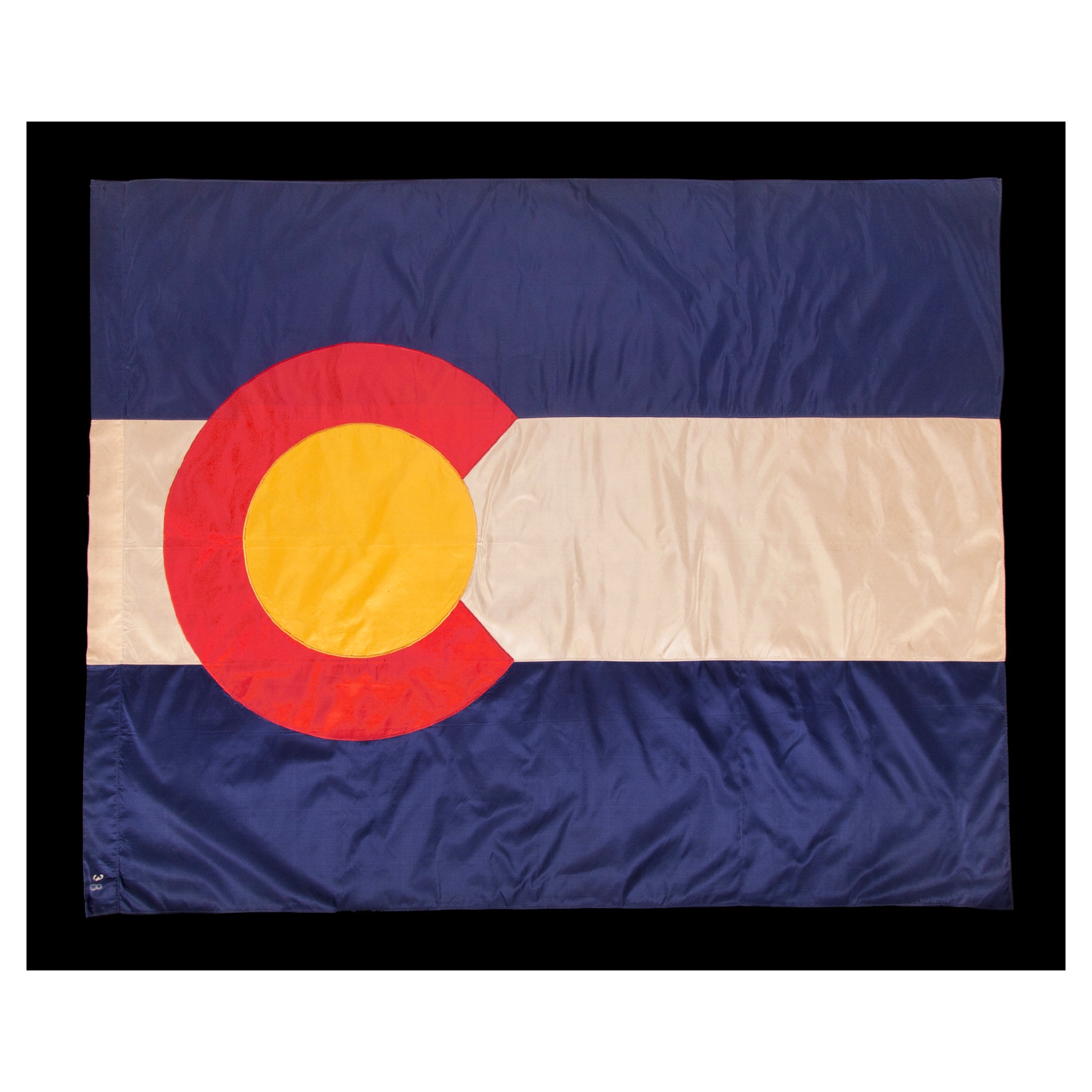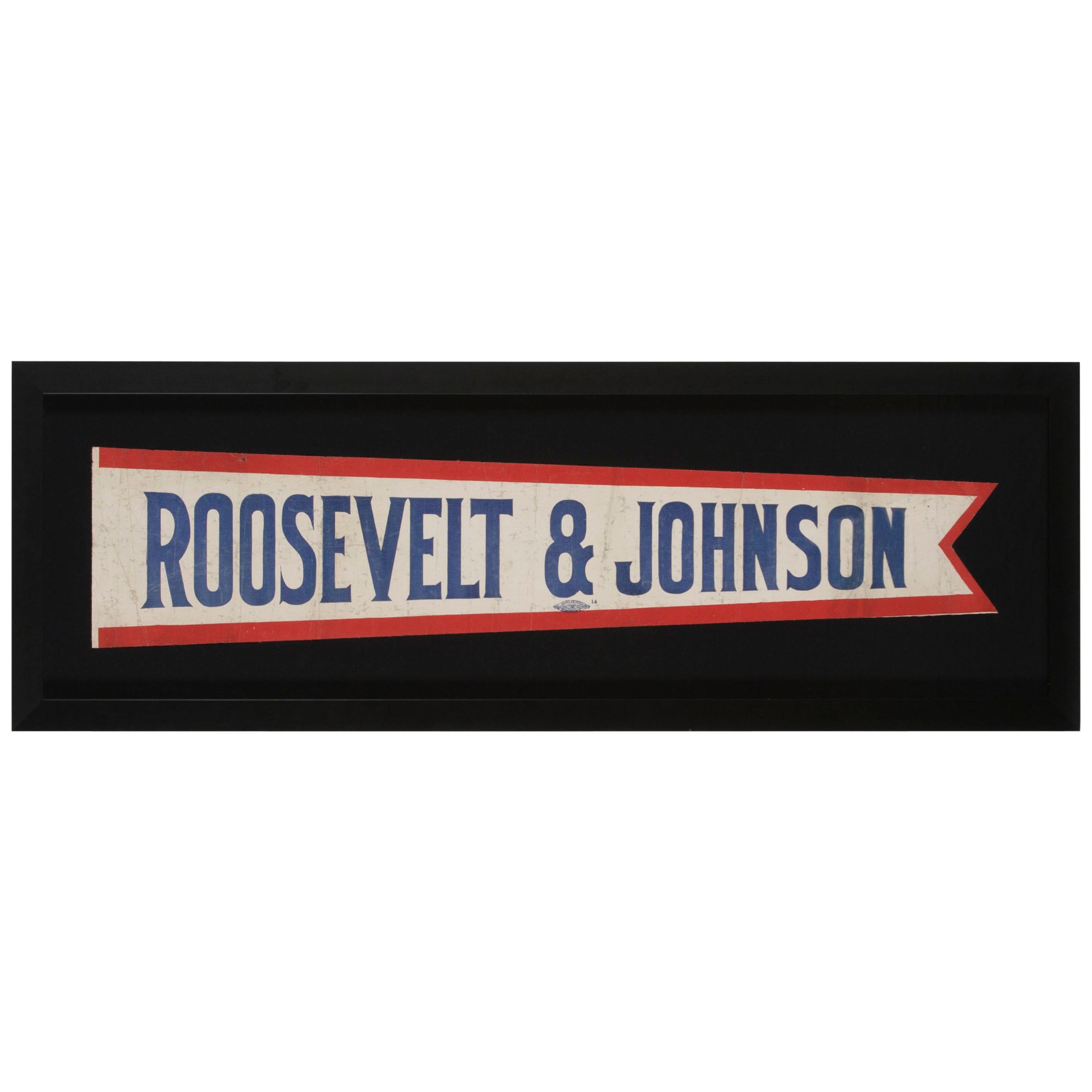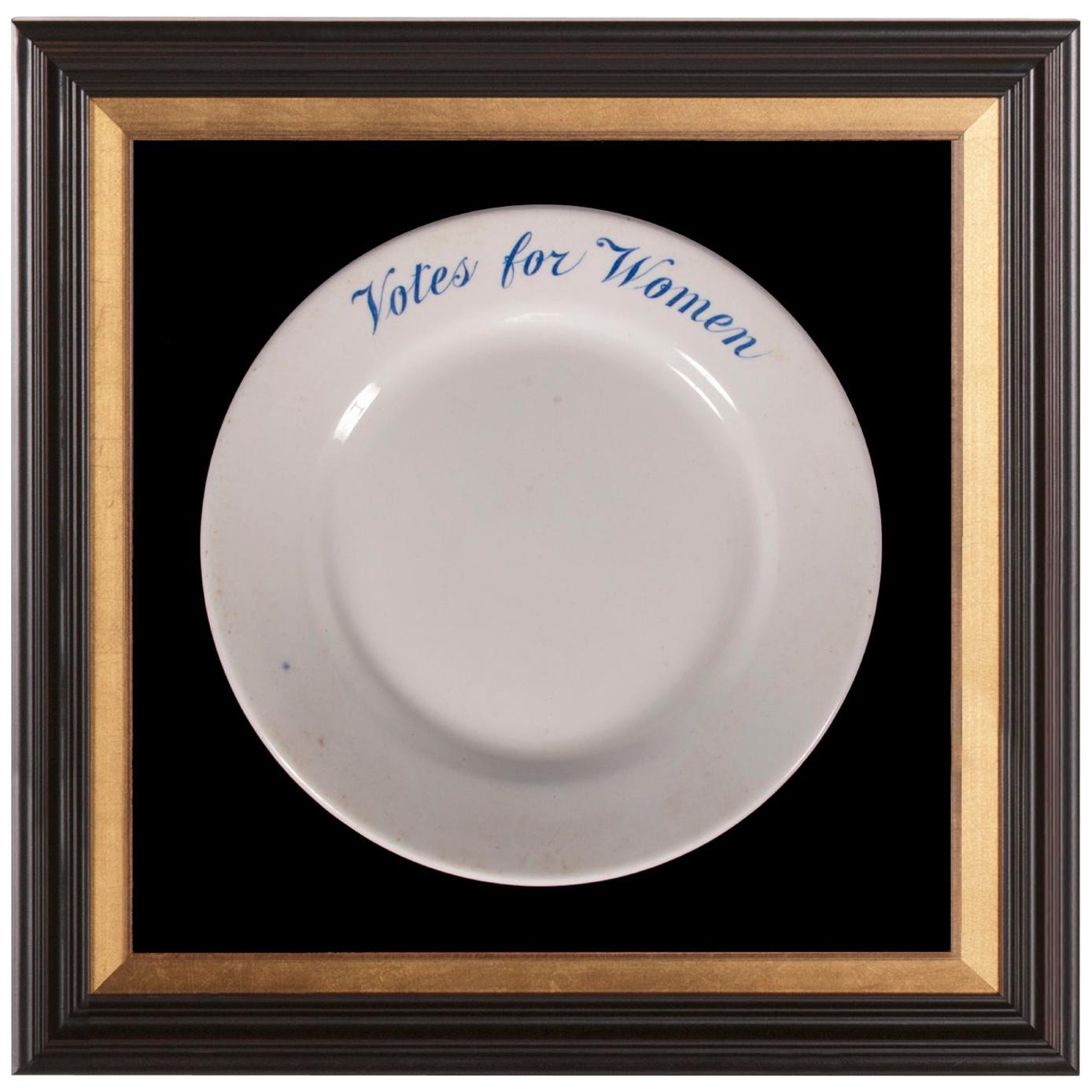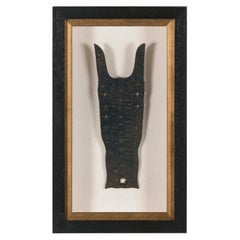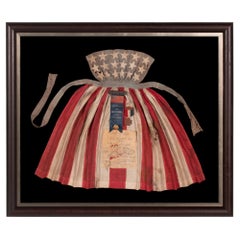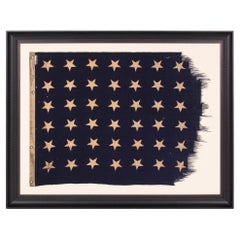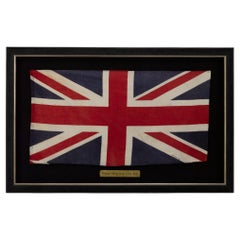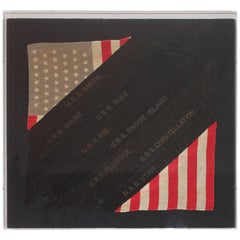
UNION JACK, MADE BY J.J. TURNER & SONS
View Similar Items
Want more images or videos?
Request additional images or videos from the seller
1 of 3
UNION JACK, MADE BY J.J. TURNER & SONS
About the Item
British Union Jack in a design typical for nautical use, with attractive, elongated features. Made sometime between approximately 1890 and WWI (British involvement 1914-1918), the body of the flag is made of wool bunting that has been pieced and sewn by machine. The triangular, red gussets at the top and bottom of the hoist (additional fabric added for support) are both original and unusual. There is a heavy canvas sleeve along the hoist, through which a rope was inserted. In the center of the sleeve there is an embroidered tag that reads: J.J. Turner & Sons; Manufacturers; Peterborough, Ont. [Ontario] The following information is taken from the archives of the Peterborough Museum: “The J.J. Turner Company was established about 1870 in Port Hope, Ontario. It re-located to Peterborough in 1887. In 1914 the company was described as the largest maker of tents, sails and awnings in Canada. In 1908 it employed 68 workers in a 20,000 square foot factory in downtown Peterborough. It was at one time, among Peterborough's ten largest employers. The factory contained a blacksmiths shop, carpentry shop and other large scale workshops. J.J. Turner also had a nation-wide marketing and distribution network”. In a 1920 catalogue, Turner listed itself as a maker of “sails, tents, awnings, flags, and camp equipment. In a 1932 catalogue, J.J. Turner & Sons listed itself as a maker of “canvas tents, camping gear, canoes, skiffs, canoe sails, flags, banners and a variety of other products”. For at least part of its existence, the company was located at 140 King Street. The building still exists today and is known as the J.J. Turner Building. The company still existed in 1975 under the name Turner Company. Some interesting facts about British flags: No law has ever been passed to make the Union jack the national flag of the United Kingdom. Instead it has become so through precedent. Its first recorded recognition as a national flag came in 1908, when it was stated in Parliament that "the Union Jack should be regarded as the National flag". A more categorical statement was made by the Home Secretary, Sir John Gilmour, in 1933 when he stated that "the Union Jack is the National Flag". It is still officially a flag of the monarch, however, rather than the country. Civilian use of the Union Jack is permitted on land, but non-naval/military use at sea is prohibited. On land, the Union Jack can be flown by any individual or organization on any day they wish. Until very recently, however, government was strictly regulated. Prior to 2007, it could only be flown on government buildings on days certain specified days, such as those marking the birthdays of members of the Royal Family, the wedding anniversary of the Monarch, Commonwealth Day, Accession Day, Coronation Day, The Queen's official birthday, Remembrance Sunday and on the days of the State Opening and prorogation of Parliament. At sea, different rules apply. Prior to 1864, the Red Ensign, White Ensign, and Blue Ensign were all flown by ships of the Royal Navy (RN). In that year, all RN ships were ordered to fly the White Ensign and it became the sole naval flag of the United Kingdom. Until the mid- to late 1960's, the White Ensign was also flown by Canadian, Australian and New Zealand warships. The Blue Ensign was reserved for merchant vessels whose masters are qualified Royal Naval Reserve [RNR] officers and which meet certain other requirements, while the Red Ensign became the British civil ensign. When flown from the bows of RN ships, the Union Jack is the British naval jack. When flown from the mast in 2:3 proportions, it is the rank flag of an Admiral of the Fleet. At sea, the Union Jack is reserved for the RN and no other British ships are permitted to fly it.
Mounting: The flag is not currently mounted. For an additional charge it can be stitched to 100% cotton and placed over an acid free strainer. It can also be encased in a u.v. protective, plexiglas museum box, or framed in a traditional manner.
Condition: There are minor holes throughout, accompanied by minor foxing and stainin
- Place of Origin:Canada
- Period:
- Date of Manufacture:1914-1918
- Condition:See Item Description.
- Seller Location:York County, PA
- Reference Number:Seller: BRITj-8131stDibs: U1002228497218
About the Seller
5.0
Recognized Seller
These prestigious sellers are industry leaders and represent the highest echelon for item quality and design.
Established in 1991
1stDibs seller since 2008
61 sales on 1stDibs
Typical response time: 10 hours
More From This SellerView All
- Cast Iron Boot Jack Made for 1864 Presidential Campaign of George McClellanLocated in York County, PACAST IRON BOOT JACK, MADE FOR THE 1864 PRESIDENTIAL CAMPAIGN OF GENERAL GEORGE B. MC CLELLAN, WITH A FANTASTIC SLOGAN THAT READS "THE UNION AT ALL HAZZARDS" Made for the 1864 presidential run of George B. McClellan, this cast iron bootjack is both rare and graphically exceptional. Displaying the original black-painted surface, with attractive and desirable patina, the stylized profile has a wonderful folk art quality. Molded block letters that wrap around the heel clasp read simply "Gen. Mc Clellan. These are accompanied by a prominent Civil War-associated slogan: "The Union at all Hazards." The text is intermingled with 34 stars, which was equivalent to the number of states during the opening two years of the war, but was one star short by mid-1863 and two stars short by the time of the actual election in 1864. It's not unusual to encounter this feature in civil war campaign parade flags as well as all manner of flag-related ephemera. The iron was reportedly cast by G. & D. Cross of Morrisville, New York, though it is unsigned and I have not yet verified the attribution. I have seen two other examples, one of which had a broken and repaired tine on the U-shaped horns and newly painted surface, while the other appeared to have broken lifters and inferior, rusted patina. This is, hands-down, the best of the identified examples. Brief History of the 1864 Campaign: President Abraham Lincoln had a checkered relationship with his 1864 opponent, who he had formerly chosen as General-in-Chief of the entire Union Army. The career officer repeatedly knocked heads with his Commander-in-Chief. Having raised a well-trained and organized military force, McClellan often seemed reluctant to use it. By 1862, after losses in Virginia during the Peninsula Campaign, Lincoln grew frustrated with McClellan and the progression of the war and removed him from command. By the early part of 1864 the American people shared some of the same frustrations and Lincoln was no longer the clear choice for the White House. The nation was tired of war and the remains of the Democratic Party...Category
Antique 1860s American Political and Patriotic Memorabilia
MaterialsIron
- Civil War Apron, Made In Cambridge, OH by Laura, Hynes, ca 1861Located in York County, PACIVIL WAR PERIOD APRON, MADE IN CAMBRIDGE, OHIO IN 1861 BY 12-YEAR-OLD LAURA HAYNES, WORN BY HER AT BENEFITS FOR THE U.S. SANITARY COMMISSION, PREDECESSOR OF THE RED CROSS, THAT STAFFED, FUNDED, AND MODERNIZED CIVIL WAR HOSPITALS Laura Haynes was born on the 17th of June, 1847 to Vincent and Sarah (Dillon) Haynes of Westland, Ohio (southeast of Columbus and due south of Zanesville). Vincent was listed as a physician in the 1850 U.S. Census, then as a lawyer in 1860, apparently having pursued both fields. It stands to reason that that during the Civil War (1861-1865), the Haynes family, being of means and with Vincent involved in the medical profession, might become involved in philanthropy to benefit Civil War hospitals. Made of plain weave cotton, this patriotic apron features 18 white, appliquéd, hand-sewn stars on a blue ground, cinched at the waist, with a blue belt incorporated below, followed by 13 vertical stripes, alternating red and white, likewise cinched, so that top and bottom have opposing triangular profiles. Aprons of this period did not generally have a loop or tie that went about the neck, to keep the breast portion up, but were rather pinned in place. All of the construction was accomplished by hand-stitching. One can see in the more crude stitching of the stars, how much more difficult it was to perform appliqué work than it was to hem fabric, especially for a 12-year-old girl. While the count of 18 stars may have had no purpose other than to fill the available space, to create a patriotic display, it may just as likely have been selected to reflect the number of states that were felt to be loyal to the Union at the time. Until July 4th, 1861, there were officially 33 stars on the American national flag. This, less the entire complement of 15 Slave States, would arrive at a count of 18. President Abraham Lincoln urged the nation not to do this, desiring not to give credence to secession, with his goal of keeping the Union together. But there were no flag police and people did as they wished, creating versions of the Stars & Stripes in both the North and the South that removed those the respective maker(s) deemed loyal to the opposition. Although rare, a number of American flags of the Civil War era are known that display 18 stars, likely to reflect the removal of 15 Southern States. In the upper center of the striped portion of the apron is a fraternal ribbon, made of blue satin silk, with a white metal brooch at the top and a gold button with an eagle below. This is decorated with a printed 13 star flag ribbon (applied), and with gilded text that reads: “The Women and Girl Workers of the Civil War; ’61-’65.” Next to this is the membership badge of the Women’s Relief Corp, which served as the women’s auxiliary of the Grand Army of the Republic, the primary organization for Civil War veterans. Below these, a hand-lettered exhibition tag was adhered, that reads as follows: “Made in 1861 at Cambridge Ohio by Laura Haynes; Age 12 Years; and Worn at Benefits for the Sanitary Commission [The Red Cross of 1861-5],” Followed by “Laura H. Green; Hotel St Mark; Oakland Calf.” Along the bottom of the tag is a brief title: “Flag-Apron of 1861-5,” with a circled item number “27.” The Sanitary Commission was founded in the Spring of 1861 by private citizens in New York City, who were appalled by the Army’s lack of medical supplies and sanitary conditions in the care of Civil War soldiers. Officially sanctioned by the War Department on June 9th of that year, and approved by Abraham Lincoln on June 13th, the chief planner and organizer was Boston-born writer and Harvard-educated clergyman, Henry Whitney Bellows of New York (b. 1814, d. 1882). Bellows modeled the organization after the work of Florence Nightingale in the British Sanitary Commission of the 1850’s, and brought with him a force of volunteers belonging to an organization he led called the Woman’s Central Association of Relief of New York. In 1863, Bellows would become one of the four founders of the Union League Club of New York, with fellow Sanitary Commission leaders Frederick Law Olmsted (the designer of Central Park, considered to be the father of modern landscape architecture,) plus George Templeton Strong (American composer, painter, lawyer, and prolific diarist), and Oliver Wolcott Gibbs (Harvard professor, chemist, and physician). The goal of the Union League Club was to join like-minded and influential, moneyed men with the cause of both the Commission and the Union in general. In 1881, Sanitary Commission nurse Clara Barton would carry the torch forward, expanding upon the concept to form the Red Cross. Sanitary Fairs—large, fundraising events held to benefit the Commission—were held in New York, Philadelphia, Baltimore, Chicago, St. Louis, and elsewhere. The Northern Ohio Sanitary Fair was almost certainly attended by Laura Haynes, 16 years old by that time, who is likely to have worn the apron there. Held in Cleveland from Feb. 22nd – Mar. 10th, 1864, the fair was opened by Major General James Garfield, future President of the United States, who, it is said, was extremely well received. About 3 years later, on June 11th, 1868, Laura married Robert M. Green of Cambridge, Ohio (northeast of Westland), who shared her June 17th birthday. Born 2 years prior to Laura, in 1846, Robert enlisted as a Corporal with “A” company of the 85th Ohio Infantry, a 3-month unit, on May 27th, 1862. Mustering in on June 10th, I Columbus, at Camp Chase, the 85th was assigned to guard Confederate prisoners at the garrison. He mustered out on the 23rd of September. By 1880, Robert & Laura Green had relocated to Oroville, California (Butte County...Category
Antique 1860s American Political and Patriotic Memorabilia
MaterialsCotton
Price Upon Request - 48 Star U.S Navy Jack Flown on the USS FT. Mandan, ca 1945Located in York County, PA48 STAR U.S. NAVY JACK, MARKED AS HAVING BEEN FLOWN ON THE U.S.S. FT. MANDAN, LAUNCHED NEAR THE END OF WWII, IN 1945, WITH SERVICE DURING BOTH THE KOREAN AND VIETNAM WAR ERAS, IN THE...Category
Vintage 1940s American Political and Patriotic Memorabilia
MaterialsWool
Price Upon Request - 13 Hand-Embordered Stars Made by Great-Granddaughter of Betsy Ross, Sarah WilsonLocated in York County, PA13 HAND-EMBROIDERED STARS AND EXPERTLY HAND-SEWN STRIPES ON AN ANTIQUE AMERICAN FLAG MADE IN PHILADELPHIA BY SARAH M. WILSON, GREAT-GRANDDAUGHTER OF BETSY ROSS, SIGNED & DATED 1911: ...Category
Vintage 1910s American Political and Patriotic Memorabilia
MaterialsSilk
- 13 Star, Betsy Ross Pattern Flag, Made by the Annin Company, ca 1955-1965Located in York County, PA13 STARS IN THE BETSY ROSS PATTERN, ON A VINTAGE AMERICAN FLAG, MADE BY THE ANNIN COMPANY OF NEW YORK & NEW JERSEY, circa 1955 - 1965 13 star American national flag, made entirely of cotton by the Annin Company of New York & New Jersey, in the period between approximately 1955-1965. The stars are arranged in the circular wreath pattern most often associated with Betsy Ross. Flags in this design are widely admired, due to the longstanding popularity of the Ross family myth. While many Americans were taught in grammar school that this was what our first flag looked like, there is, unfortunately, no way to substantiate the claim, and no colonial flags...Category
Late 20th Century American Political and Patriotic Memorabilia
MaterialsCotton
- Colorado State Flag, Made of Silk, Ca 1911-1920Located in York County, PACOLORADO STATE FLAG OF EXCEPTIONAL QUALITY, MADE OF SILK, CIRCA 1911-1920’s, EXTRAORDINARILY RARE IN THIS PERIOD AND THE EARLIEST EXAMPLE THAT I HAVE EVER ENCOUNTERED Early state flags are few and far between. While I am asked for them constantly, most states did not actually have official flags until the 20th century. On May 6th, 1911, Colorado became among the last to adopt a design. The project of doing so was spearheaded by the Denver Chapter of the Daughters of the American Revolution. The bill was introduced by Senator W.H. Sharply and adopted by the Eighteenth General Assembly. The artwork was the product of A.C. [Andrew Carlisle] Carson, President of the Ohio Society of Colorado. The meanings behind the elements in the design are as follows: The large letter "C" stands for Colorado and simultaneously for the Centennial State (Colorado entered the Union in 1876, the year in which our nation celebrated its 100th anniversary of independence), as well as the Columbine State (reflecting the state flower). The red color is included due to the fact that the word Colorado translates to scarlet or red in Spanish. The circle represents the sun, while the gold color symbolizes all-the-year sunshine, Colorado’s status as the greatest gold state, and one Columbine color. It was also included so that the Colorado state flag would have one more color than the U.S. flag. The color white reflects Colorado’s status as the greatest silver state, its eternal mountain snow, and one Columbine color. Lastly, the shade of Yale blue symbolizes all-the-year blue sky and one Columbine Color. Members of the D.A.R. were proud to note that this was also their color. Made sometime between the initial year of the adoption of this design and the 1920’s, this particular flag is the earliest Colorado example that I have ever encountered. The blue and white bars, red “C,” and golden circle are a’’ made of silk taffeta. This was a costly fabric, reserved for the best material a flag-maker produced. The flag is constructed in the manner of a battle flag, to be carried on foot. Squarish in its overall profile, silk was the fabric of choice for flags employed in this function, due to the fact that it was light weight, and thus practical for hand-carrying, while simultaneously formal in appearance, appropriate for the sort of ceremonial use that military presentation often demands. The style of the hoist is also typical for field or parade use. Here the fabric was rolled over to form an open sleeve, through which a wooden staff could be inserted. The sleeve is lined on the interior with black cotton. Leather tabs, at the top and bottom, fit over metal posts on the staff, designed to accept them, to fix the flag in its proper position. The bars were pieced and joined with lineal machine stitching. The hoist and fly ends were finished and hemmed by the same method. The devices are double-appliquéd (applied to both sides) with a machine buttonhole / blanket stitch. Though machines that produced buttonholes were, remarkably, available alongside the earliest standard machines, in the 1850’s and 60’s, the use of this sort of stitch in a running format, for appliqué work, remained highly unusual, even as late as the first half of the twentieth century, probably because it used a ton of thread when compared to the zigzag or satin stitch. It could be expected to appear more often in the hands of a maker of very fine flags, that employed embroidery machines and commissioned custom, fancy work of all sorts. Though unsigned—in no way uncommon in early examples, which were seldom signed—that is precisely the sort of firm that produced the Colorado flag...Category
Early 20th Century American Political and Patriotic Memorabilia
MaterialsSilk
Price Upon Request
You May Also Like
- Vintage Union Jack, Circa 1950sLocated in Colorado Springs, COThis is a beautiful Union Jack parade flag, dating from the early 1950s, during the early years of Queen Elizabeth II's reign. The flag is printed on cotton, with machine-sewn hemmed...Category
Vintage 1950s English Mid-Century Modern Political and Patriotic Memorab...
MaterialsCotton
- Framed Hand Sewn Patriotic Sham Made from a Flag and Ship RibbonsLocated in Los Angeles, CAThis Great framed Folk Art sham with 48star flag and ship ribbons is a great patriotic item. The top left corner as well as the bottom right corner are scraps of a 48 star linen flag and in between them are ribbons of ships names that are sewn together in a collage. The American ships span three centuries of ships ribbons, from late 19th century to present day ships. As well as the "USS Utah" which was sunk during the attack on Pearl Harbor. This great and proud sham is not only a great American item but is a Symbol of hope and unity throughout the ages. Serves better as a hanging Folk Art...Category
20th Century American Folk Art Political and Patriotic Memorabilia
MaterialsPlexiglass
$1,195 Sale Price29% Off - Mr. Dooley at His Best, by Finley Peter Dunne Edited by Elmer EllisLocated in valatie, NYMr. Dooley at His Best. Edited by Elmer Ellis at the University of Missouri. With a Foreword by Franklin P. Adams. New York: Charles Scribner's Sons, 1938. First edition, 1st printing, one of 520 copies with one page of the author's original manuscript. Frontispiece portrait. 291 pp. Buckram and decorated boards with a leather label. Finley Peter Dunne (1867- 1936) was an American humorist and writer from Chicago. In 1898 Dunne published Mr. Dooley in Peace and in War, a collection of his nationally syndicated Mr. Dooley sketches. Speaking with the thick verbiage and accent of an Irish immigrant from County Roscommon, the fictional Mr. Dooley expounded upon political and social issues of the day from his South Side Chicago Irish pub...Category
Vintage 1930s American Books
MaterialsPaper
- "The Second World War, " by Winston ChurchillBy Houghton Mifflin & Co.Located in Austin, TXThe Second World War by Winston Churchill from Houghton-Mifflin Company, Boston. A vintage edition of Winston Churchill's six-volume memoir, The Second World War, for which he was a...Category
Mid-20th Century American Modern Books
MaterialsPaper
- Eagle and Flag Bronze Sculpture by Lorenzo E. Ghiglieri, Limited Edition 205/475Located in Colorado Springs, COPresented is a patinated bronze eagle by Lorenzo E. Ghiglieri. The eagle is depicted landing on a tree stump, with wings dramatically raised. The stump is draped with a polychrome American flag. The bronze is signed "Lorenzo Ghiglieri...Category
Late 20th Century American Animal Sculptures
MaterialsBronze
- Antique 13-Star Patriotic Sash by Louis E. Stilz & Bros., Late 19th CenturyLocated in Colorado Springs, COPresented is an original patriotic sash from the late 19th century, featuring 13 stars against a bright blue field. This sash features appliqued silver stars on a blue canton, red an...Category
Antique Late 19th Century American Historical Memorabilia
MaterialsCotton
